Archived Water Damage Blog Posts
Why Choose Team Shaw for Emergency Restoration Services
12/2/2024 (Permalink)
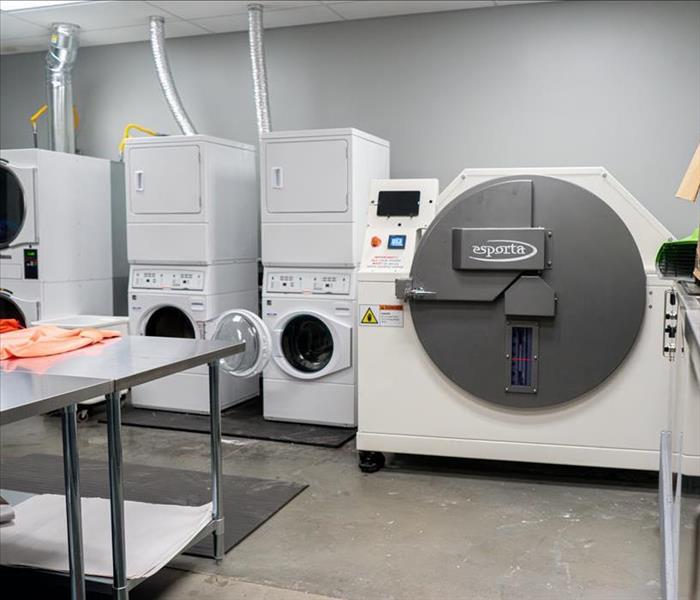 State of the art cleaning equipment at warehouse
State of the art cleaning equipment at warehouse
When disaster strikes, it can be overwhelming to face the damage caused by fire or water. Whether it’s a burst pipe, a kitchen fire, or storm-related flooding, time is of the essence to minimize the damage and start the restoration process. That’s where Team Shaw comes in. We’re proud to be the trusted partner for fire and water restoration in our community, offering swift, professional, and compassionate service when you need it most.
Comprehensive Fire and Water Restoration Services
At Team Shaw, we provide full-service restoration to handle every aspect of damage caused by fire or water, including:
- Water Damage Restoration: Rapid water extraction, structural drying, and repair to prevent mold and long-term damage.
- Fire Damage Restoration: Cleaning soot and smoke residues, odor removal, and repairing structural damage.
- Emergency Board-Up Services: Protecting your property from further damage or theft during the restoration process.
- Mold Remediation: Identifying and removing mold caused by water damage to restore a safe environment.
- Reconstruction Services: Rebuilding damaged areas to restore your property to pre-damage condition.
Why Choose Team Shaw?
1. 24/7 Emergency Response
Disasters don’t wait for business hours, and neither do we. Our team is available around the clock to respond to emergencies and start mitigating damage immediately.
2. Faster to Any Disaster
With our local presence and extensive resources, we guarantee a quick response to minimize damage and reduce restoration time. Our team arrives prepared with advanced equipment and a clear action plan.
3. Highly Trained Restoration Specialists
Our technicians are certified and extensively trained in fire and water restoration. From handling soot-covered walls to drying water-logged carpets, we use proven methods and advanced technology to ensure the best results.
4. Advanced Technology and Equipment
We use state-of-the-art equipment for water extraction, drying, air purification, and odor removal. Our advanced cleaning techniques restore your property and belongings with precision and care.
5. We Handle the Stress of Insurance
Navigating insurance claims after a disaster can be a daunting task. Our team assists with documentation and works directly with your insurance company to streamline the claims process, ensuring you receive the coverage you need.
6. Locally Owned and Operated with National Support
As a local business, we understand the specific needs of the Town & Country community. At the same time, we have access to extensive resources to handle large-scale disasters efficiently.
A Partner You Can Count On
Disasters can be devastating, but you don’t have to face them alone. Team Shaw is committed to restoring your property and peace of mind. With our expertise, compassion, and dedication to excellence, we make it our mission to help you recover as quickly as possible.
When fire or water damage strikes, choose Team Shaw. Contact us today for reliable, professional restoration services and experience the difference a trusted partner can make.
Water Damage Restoration Technology: Innovations and Advancements
10/23/2023 (Permalink)
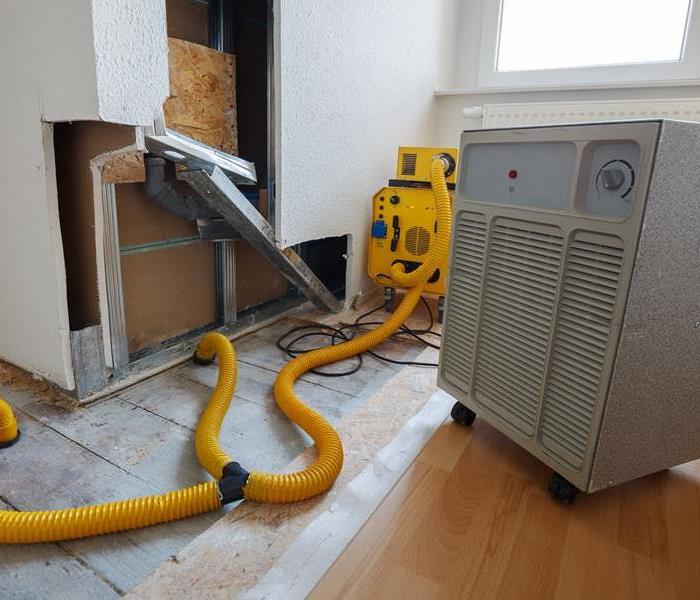 SERVPRO has technology unique in the restoration industry to restore your property back to pre loss conditions.
SERVPRO has technology unique in the restoration industry to restore your property back to pre loss conditions.
Water damage is a common issue for homeowners, and as technology advances, so do the tools and methods used to restore damaged properties. In this blog post, we will discuss some of the innovations and advancements in water damage restoration technology that are changing the industry for the better.
Moisture Detection
- Thermal Imaging Cameras: These cameras use infrared technology to detect and visualize temperature differences, allowing professionals to identify moisture in areas that may not be visible to the naked eye.
- Moisture Sensors: These handheld devices are used to identify moisture levels in building materials, such as drywall and framing, providing professionals with real-time data to inform their restoration practices.
Water Extraction
- High-Pressure Water Extraction Systems: These systems use powerful vacuums and pumps to remove water quickly and efficiently from flooded areas, reducing the likelihood of further water damage.
- Submersible Pumps: Submersible pumps are designed to remove large volumes of water, making them ideal for use in extreme flooding situations.
Drying Equipment
- Dehumidifiers: Dehumidifiers remove moisture from the air and surfaces, reducing humidity levels to promote faster drying times and prevent mold growth.
- Air Movers: Air movers are high-powered fans that circulate air to speed up the drying process and promote evaporation.
Air and Surface Sanitization
- UV-C Light Systems: Ultraviolet-C light systems use a special type of ultraviolet light that damages the DNA and RNA of bacteria and viruses, effectively killing them and sanitizing the air and surfaces.
- Ozone Generators: Ozone generators produce ozone, a gas that breaks down bacteria and viruses on surfaces and in the air.
Structural Drying
- Heat Drying Systems: Heat drying systems use specialized heaters and fans to increase the temperature and airflow in affected areas, promoting faster drying and reducing the likelihood of mold growth.
- Desiccant Dehumidifiers: Desiccant dehumidifiers use a special drying agent to remove moisture from the air, making them ideal for use in cold or humid environments where traditional dehumidifiers may not be as effective.
Remote Monitoring Technology
Environmental Monitoring Systems. These systems use sensors and cameras to monitor temperature, humidity, and other environmental factors in real-time, allowing professionals to adjust their restoration practices as needed. Remote monitoring apps allow homeowners and restoration professionals to monitor the drying process and receive alerts about changes in environmental conditions or potential equipment malfunctions.
Technology is transforming the water damage restoration industry, enabling professionals to respond to emergencies more efficiently and effectively than ever before. With an array of new tools and practices at their disposal, they can quickly assess and address water damage issues, minimizing the extent of the damage and reducing the cost of recovery. As technology continues to evolve, the potential for even more innovative and effective solutions will emerge, creating safer and more resilient homes and communities.
Understanding Secondary Water Damage: Causes, Effects, and Prevention
8/10/2023 (Permalink)
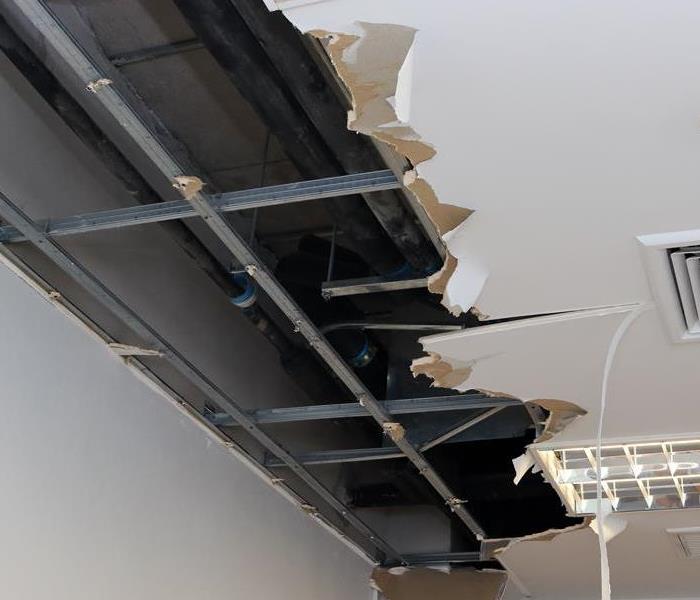 Secondary water damage can be costly. Act quick to prevent future damage.
Secondary water damage can be costly. Act quick to prevent future damage.
Water damage is a significant concern for homeowners and property managers, but it's not just the immediate effects of water intrusion that you need to worry about. Secondary water damage can occur if the initial water damage is not properly addressed or if it goes unnoticed for an extended period. In this blog, we will explore what secondary water damage is, its causes, effects, and most importantly, how to prevent it. Understanding and taking proactive measures against secondary water damage can save you from further costly repairs and potential health hazards.
Defining Secondary Water Damage
Secondary water damage refers to the additional harm that arises as a result of prolonged exposure to moisture or the improper drying of an initially affected area. It occurs when water seeps into building materials, such as drywall, flooring, or insulation, and causes damage over time. Secondary water damage can include mold growth, structural deterioration, weakened foundations, and compromised indoor air quality.
Causes of Secondary Water Damage
- Delayed or Inadequate Water Extraction: If the initial water intrusion is not promptly addressed or if inadequate measures are taken to extract the water, excess moisture can remain in the affected area. This prolonged exposure can lead to the development of secondary water damage.
- Poor Ventilation and Air Circulation: Insufficient airflow and ventilation impede the drying process. Without proper circulation, moisture can become trapped within walls, flooring, or other porous materials, leading to secondary damage.
- High Humidity Levels: High humidity levels in an environment affected by water damage can create a favorable breeding ground for mold growth and other microbial activity. Mold spores can quickly spread throughout the property and cause significant secondary damage.
- Plumbing Issues: If the initial water damage is caused by a plumbing issue that goes undetected or unrepaired, continuous water leakage can exacerbate the damage and result in secondary problems such as rotting wood, mold growth, and structural deterioration.
Effects of Secondary Water Damage
Excess moisture provides the ideal conditions for mold spores to thrive. Mold growth not only damages surfaces and materials but causes secondary damages. Prolonged exposure to moisture weakens the structural integrity of building materials. Wood may warp, swell, or rot, and drywall may deteriorate, compromising the stability and safety of the property.
Lingering moisture and mold growth contribute to unpleasant odors and poor indoor air quality. This can lead to discomfort, respiratory problems, and potential long-term health issues. Secondary water damage often requires more extensive repairs and restoration efforts compared to the initial damage. Mold remediation, structural repairs, and the replacement of damaged materials can significantly increase the overall cost of restoration.
Preventing Secondary Water Damage
- Act promptly: Address water damage immediately to minimize its impact and prevent secondary damage. Swiftly extract water, dry affected areas, and address the source of the water intrusion.
- Thoroughly Dry the Area: Ensure proper drying by using dehumidifiers, fans, and ventilation systems. Consider employing professional drying equipment and techniques for large-scale or severe water damage situations.
- Inspect for Hidden Damage: Conduct a thorough inspection of the affected area, including hidden spaces such as behind walls or under flooring. This helps identify any potential moisture pockets that may lead to secondary damage.
- Properly Ventilate: Maintain good airflow and ventilation throughout the property. Regularly inspect and clean ventilation systems, including HVAC units and air ducts, to prevent moisture buildup and mold growth.
- Monitor Humidity Levels: Use a hygrometer to monitor indoor humidity levels. Keep them below 60% to discourage mold growth and minimize the risk of secondary damage.
- Regular Maintenance: Conduct routine inspections of plumbing systems, roof, and foundation to detect and address any potential issues that may cause water damage.
Secondary water damage can be a costly and potentially hazardous consequence of water intrusion. By understanding its causes, effects, and prevention measures, you can take proactive steps to mitigate the risk of secondary damage. Remember, early intervention and preventive measures are key to preserving the integrity and safety of your home or building.
Why is my water heater leaking?
3/10/2023 (Permalink)
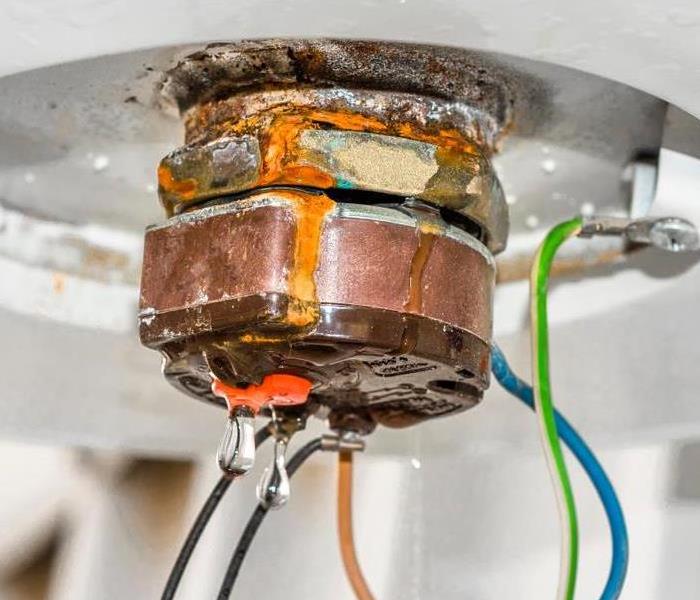 Call a professional for your water heater repairs.
Call a professional for your water heater repairs.
Leaking water heaters are a common occurrence. Even if you have your water heater regularly serviced, it can still develop issues over time that cause it to leak. There are several different causes of leaking water heaters, but the most common ones include:
- A cracked or broken tank can cause water to leak through the floor;. This is a major problem that requires immediate attention because it could lead to extensive damage if not repaired quickly. A crack in a tank can also allow corrosion from minerals that build up in tap water into your appliance's internal components.
- Pipes can fracture or leak due to the corrosive effects of minerals in tap water over time. If left unchecked, these leaks will continue until they become severe enough for you to notice them visibly spilling onto your flooring surface. Water damage from even small leaks can be costly because it leads over time to more serious problems such as mold growth.
Leaking water heaters are a common occurrence.
Leaking water heaters are a common occurrence. In fact, they're the most common cause of water damage in the home.
Water heaters can leak from their tanks, pipes or connections. A small amount of leakage won't cause major damage, but it's still important to keep an eye out for signs that your water heater needs repair or replacement before it causes significant damage to your home and possessions.
Water heater repair can be costly.
The average cost of a water heater repair is $300-$500, but the damage can be much more expensive. If you have to replace your water heater, it could cost around $1,000.
There are many different types of water heaters available including electric and gas models; tankless and conventional storage tank heaters, high efficiency or standard efficiency models, condensing or non-condensing boilers (or both).
Water heaters Lifespan.
Did you know that water heaters have an average lifespan of 10-15 years? If your water heater is older than that, it's important to get it checked out. A leaking or malfunctioning appliance can cause serious damage if not addressed in a timely manner.
How do I check the age of my water heater? The easiest way to find out how old your existing unit is is by looking at its serial number. This information can be found on the outside of the tank or underneath it where there are four large bolts holding it down.
Leaking from corroded Pipes.
If you notice your water heater leaking, it's possible that corrosion is the culprit. Water heaters are made of metal and as such they can be vulnerable to corrosion from minerals in tap water over time. The corrosive effects of these minerals can cause pipes and tanks to crack or break, which leads to leaks when you turn on your faucet.
The best way to prevent this issue is by installing an anti-scale system in your home's plumbing system. This will help reduce the amount of scale buildup inside your pipes so that they don't corrode as quickly as they would otherwise (and thus reduce the risk of leaks).
Broken Tank can cause water damage
Cracked or broken water heaters can cause water to leak through the floor. A damaged tank can result in a variety of problems. Water leaking out of the bottom of your heater when it's full and pressurized. An increase in energy costs because you have to run your heater longer than usual to get warm water for showers and other household activities. If there is too much pressure buildup inside of your tank, it could burst under pressure from either high heat or cold temperatures outside (or both).
Call a Professional.
If you have a water heater that's leaking, it's important to call a professional repair technician as soon as possible. A trained technician can fix the problem quickly and efficiently, saving you time and money. They'll also be able to tell you how to prevent similar problems from happening in the future so that your water heater lasts longer.
If left untreated, small leaks can lead to large amounts of damage and even more costly repairs down the road. Give SERVPRO a call today!
Can hardwood be restored after a Water Loss.
2/13/2023 (Permalink)
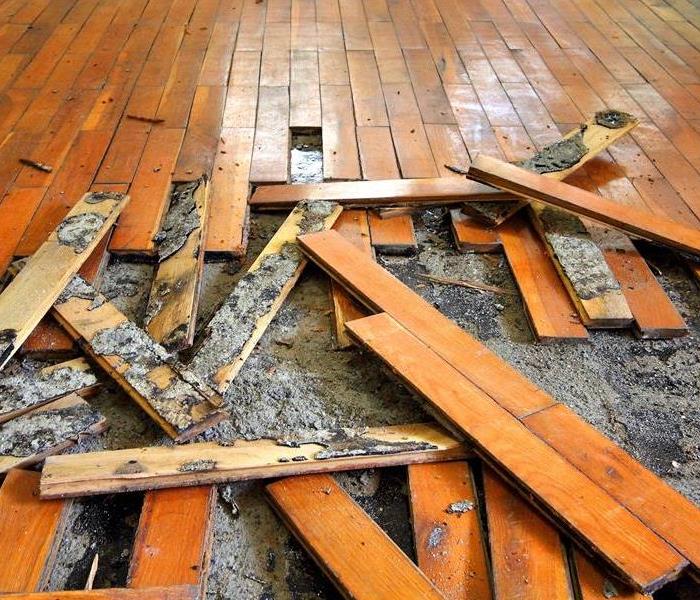 If your home suffers from a water loss, we are here to help!
If your home suffers from a water loss, we are here to help!
Water damage to hardwood floors is not only common, but can be devastating. Water will destroy the finish and the structure of your floor unless you take action immediately.
Water damage to wood floors can be caused by many things, plumbing leaks, overflowing water heaters, broken washing machines and dishwashers, overflowing toilets or sinks. Regardless of how it happened, there are steps you can take right now to save your hardwood floor from destruction.
Water Damage to Your Hardwood Floor
The damage water can cause to your hardwood floors is severe. Water damage will cause swelling, warping and cracking of the wood, as well as splitting.
Water damage can be caused by leaks, floods and overflows in a home or building. If you have water damage that needs repair, contact an expert today so they can determine how best to restore the condition of your flooring back to normal.
Causes of Water Damage to Wood Floor
There are a variety of causes that may result in water damage to your hardwood floors. These can include a leaky pipe, a burst pipe, or even broken appliances like washing machines or dishwashers. Storms can also cause water damage, if they're severe enough and leave standing water on your floor, this can cause secondary damages to your floor.
What to Do When Water Damage Strikes
If you’re dealing with a wet floor, the first thing to do is call a professional. They can help you determine if it's salvageable and what kind of repairs will be needed. Once they've arrived on the scene, remove all wet items from the area and start drying things out as much as possible before they set in place (like rugs). This will make it easier for them to dry out your wood flooring quickly and prevent secondary damage in your home.
Use air movers or dehumidifiers, if necessary, to remove moisture from the air, then use fans around the perimeter of affected areas so that warm air can circulate through them more effectively. Do not use hairdryers or other heat sources near damaged hardwood floors until they're completely dry.
How to Save Water Damaged Floors
There are several steps you can take to minimize the damage and help your floor dry quickly. Remove excess water as soon as possible. Use a wet/dry vacuum, if necessary, this will get rid of most of the moisture. If the wood is still wet after using a dehumidifier, use fans to dry it completely (this may take up to 48 hours). Save time by using hardwood floor drying kits or machines that have been specifically designed for this purpose.
The sooner you take action, the more likely it is that your damaged floor can be saved. Waiting too long can lead to irreparable damage and a need for replacement, so don't wait any longer than is absolutely necessary!
When you are in need of a restoration company, give SERVPRO of Town & Country a call at the first sign of water damage to your hardwood floors.
Benefits of Regular House Plumbing Inspections
1/9/2023 (Permalink)
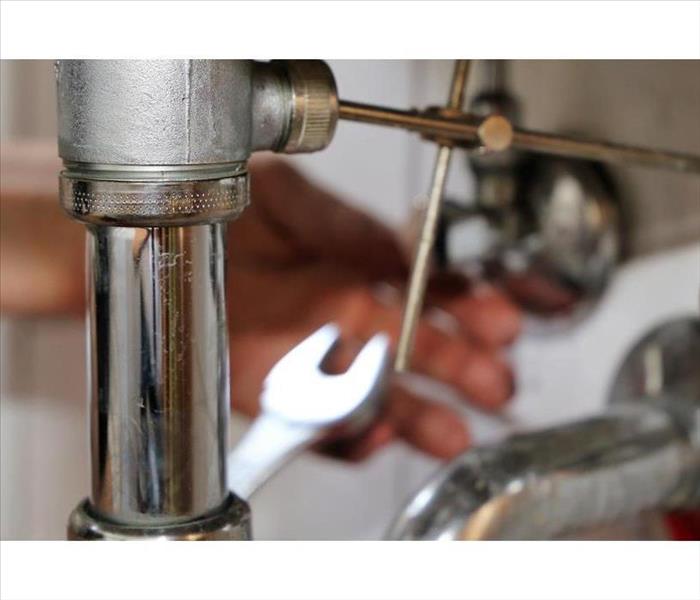 Fix plumbing leaks quickly
Fix plumbing leaks quickly
If you live in a home with an older plumbing system, it's important to have regular inspections. I'm sure you've heard of the adage "an ounce of prevention is worth a pound of cure." This couldn't be truer when it comes to house plumbing systems. House plumbing systems are prone to leaks, cracks, and other problems that can cause serious damage if left unchecked. By getting your plumbing system inspected regularly, you'll be able to spot these problems before they become too expensive or dangerous. In this article we'll explore exactly why it's so important for homeowners to get their plumbing inspected on a regular basis so that they can enjoy peace of mind knowing that their home's foundation is safe from major issues like floods and burst pipes!
1. Spot leaks, cracks, and other problems early on
When you have your plumbing inspected every few years, your plumber will be able to spot potential problems early on. By catching a possible leak or crack before it becomes a major problem, you can save yourself both time and money. If you have an emergency that requires immediate attention, it's much better to find out about the problem before it gets out of hand.
If there are any issues with your plumbing system, they'll likely show up in the inspection report, so you know what needs fixing or replacing.
2. Save on energy bills
Part of the reason you should have your plumbing inspected regularly is that they can help you save money. Why? Well, regular inspections will reveal leaks that are wasting energy and water. In addition to this, they'll also show problems with your system that could result in higher energy bills and higher water bills. Inspections are a great way to get valuable information about how you can improve your home's performance, so we highly recommend them!
3. Homeowners can significantly on their monthly water bill.
The average American family spends great sums each year on water bills, which add up over time. In fact, it’s estimated that homeowners can save up to $70 per month on their water bill by having their pipes checked by a professional plumbing inspector.
Maintaining your plumbing system can help you avoid the costs of repairing large leaks, which can cause mold and mildew in your home, as well as flooding and frozen pipes during colder months. Many people are surprised when they find out how easy it is to keep their systems functioning properly!
4. Avoid costly plumbing repairs
- Regular plumbing inspections are a good way to prevent costly repairs. Plumbing systems can be expensive to fix, and they often need repairs or replacement every few years. If you don’t have regular plumbing inspections, you may end up having to replace your entire system just because of a single issue that could have been prevented with regular maintenance.
- A common problem with plumbing is leaks. Leaking faucets and toilets can waste hundreds of gallons of water each month.
5. Prevent small issues from becoming major issues
Regular plumbing inspections are the best way to prevent small issues from becoming major problems. For example, a small leak can cause mold and mildew to grow on the walls of your home, while an improperly installed water heater can lead to carbon monoxide poisoning. The sooner you address these issues, the less expensive they will be to repair or replace!
6. Better water quality
When you get your plumbing system inspected regularly, you'll have the peace of mind that your plumbing system is in good condition. Your plumber will be able to spot problems before they become big issues and will be able to fix them before they cause damage or disruption to your household. This means that if a problem does arise, it can be dealt with quickly and easily, saving time and money.
7. When you get your plumbing system inspected regularly, you'll have the peace of mind that your plumbing system is in good condition.
This can help you sleep better at night knowing that:
- Your plumbing system is safe for use by your family and friends who visit.
- You aren't going to be surprised by a small leak or large problem with the plumbing that could lead to water damage or home damage.
- All the components are working properly and not causing any problems for other systems in your house like heating/cooling systems or doors opening/closing correctly.
The plumbing system in your Houston, TX home is a major part of your home. It is important to have it inspected regularly so you can identify any potential problems before they become an issue. When the experts at SERVPRO of Town & Country inspect your plumbing, they will make sure everything is running smoothly and efficiently. From faucets to toilets, showers, sinks, and drains.
What To Do If Your Basement Floods?
11/9/2022 (Permalink)
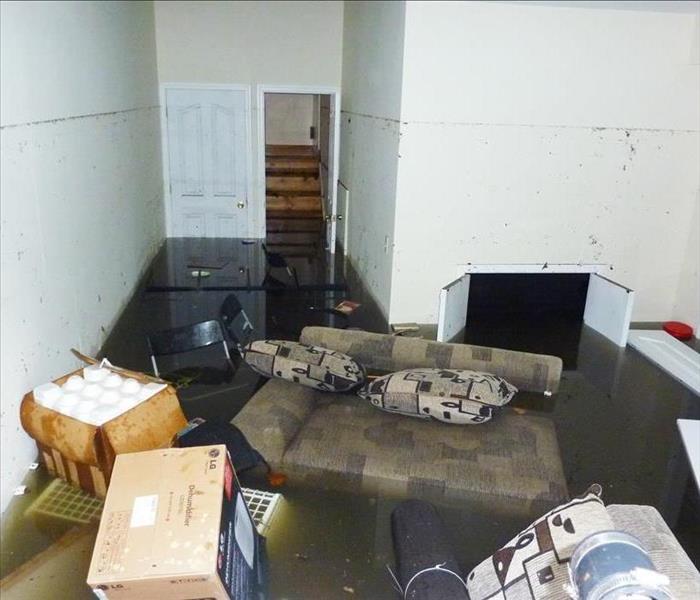 If your basement is flooded you should call SERVPRO of Town and Country.
If your basement is flooded you should call SERVPRO of Town and Country.
How Do You Handle a Flooded Basement?
If you've ever had a basement flood, you know how stressful it can be. That's why it's important to understand what to do if your basement floods and who to contact for help. A flooded basement is often caused by more than just one factor, which means that there are several different things you should consider doing to minimize damage and prevent future flooding. In this blog post we'll discuss several different scenarios that lead to flooding (and what could have prevented them), as well as steps that homeowners can take right away after a flood occurs to minimize damage and prevent further flooding.
Steps To Reduce Damage If Your Basement Has Flooded
If your basement has flooded, there are several steps you should take right away to minimize damage.
- Keep a close eye on the water level. Make sure it doesn’t rise too high or get into any other part of your home.
- Call a plumber or water damage restoration specialist as soon as possible after a flood to ensure that no additional damage occurs.
- If you have a sump pump, make sure it is working properly and doesn't need to be replaced or repaired before the next major rain event happens in your area.
Factors That Can Contribute To a Basement Flood
One of the most common is a sump pump failure, which occurs when the sump pump is not installed properly or fails when needed most. Sump pumps are also responsible for removing water from your home’s foundation and moving it outside of your house into a designated drainage system. However, if you have an older model, it may not be able to handle large amounts of rainfall in one go and could cause problems for homeowners in high-risk areas like hurricanes.
Sump pumps need to be checked regularly for proper operation—a clogged filter or worn impeller (the part that pulls water up into the discharge pipe) are just two examples of common causes for premature failure in this type of equipment. Regular inspections will also help you identify any potential issues before they become major problems that damage your home's foundation or flood your basement again!
Call a Plumber or Water Damage Restoration Specialist
As soon as possible after a flood, you should call a plumber or water damage restoration specialist to ensure that no additional damage occurs. Mold can quickly grow in your home if left untreated it can be very dangerous.
If you find yourself in need of assistance with a water problem, SERVPRO of Town and Country is here to help. We have the training, equipment, and expertise to handle any type of water damage. Our staff will be able to quickly get the work done so that you can get back to normal life as soon as possible.
For more information on what we do or if you need help with your insurance claim, contact us today at (713) 461-2700. We are available 24/7 so don’t hesitate—contact us today!
How To Clean Up a Water Heater Leak
7/23/2022 (Permalink)
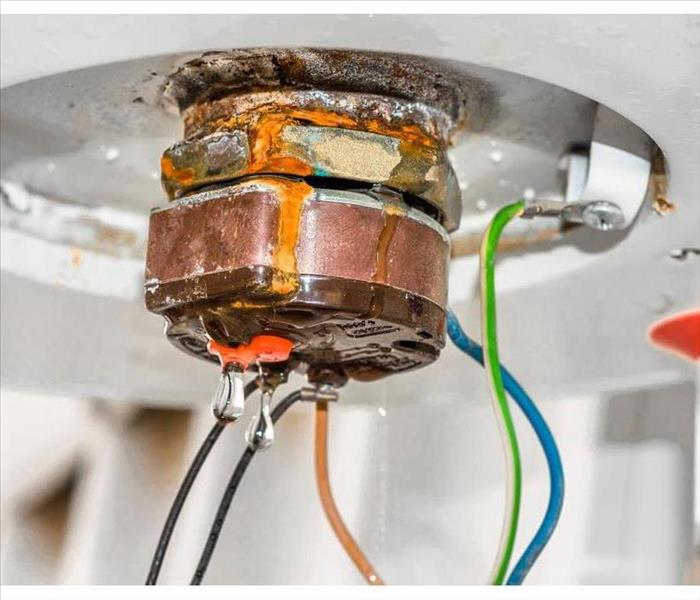 A leaking water heater should be handled with care
A leaking water heater should be handled with care
How to Fix a Leak in a Water Heater
Are you having trouble getting enough hot water? Do you notice strange sounds coming from the tank? Maybe you're seeing puddles or drips that haven't occurred before? These are signs of a leaking water heater. You deserve a warm shower without water damage. With that in mind, residents in Houston, TX, should act swiftly to remedy the issue. Here are five steps to assist in alleviating your water heating needs.
1. Seek Professional Advice
Where do you start? A water restoration company understands the importance of remediation and repair. Contact a reputable business within your area, asking for immediate arrival. They have equipment and experience, making the process smoother and more efficient.
2. Turn Off the Electricity
Your failed water heater is a hazard for you and the family. Therefore, as you wait for the professionals, protect your home and everyone in it by shutting off the electrical circuit to that zone.
3. Request Testing
Begin by determining the extent of property damage. This is important in ensuring that future complications don't arise. The crew can assess if the moisture invaded the foundation or the drywall, offering a complete picture of your replacement needs. They can also work on the leaking water heater, figuring out why the device broke. If possible, they can fix it. If they can't, they'll arrange for a new unit to be installed.
4. Remove Water
Lingering liquid can create a musty odor or damage walls. This fluid needs extraction, so the team should use dehumidifiers to draw out the excess humidity.
5. Restore the Area
Once the broken water heater is removed and the new piece is installed, specialists will begin to rebuild your room. This often includes putting in new baseboards and drywall. Painting or patching takes place to get everything back to normal.
A leaking water heater should be handled with care. Think about your safety by cutting the electricity off. Then, begin to work with a restoration team that can lead you through the appropriate remediation steps.
What To Do If a Pipe Bursts in Your Commercial Building
3/7/2022 (Permalink)
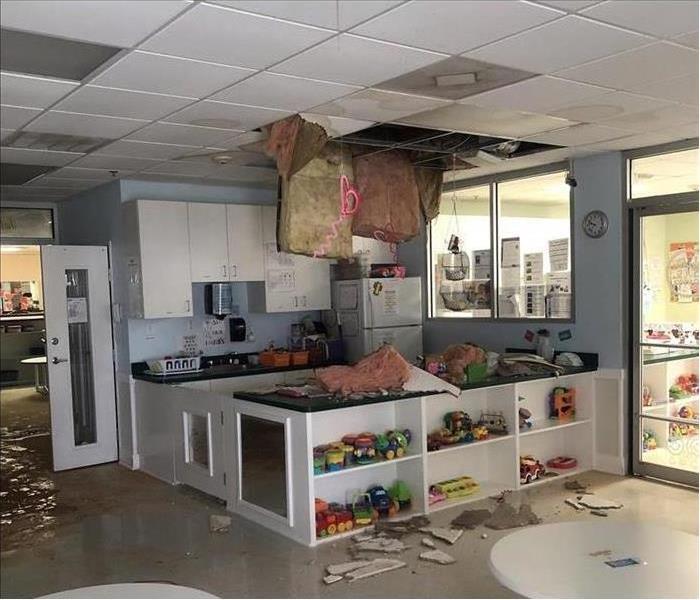 Water damage in a building in Houston, TX.
Water damage in a building in Houston, TX.
What Should You Do If a Pipe in Your Commercial Building Bursts?
Older commercial properties are particularly broken to frozen pipes. However, this phenomenon can occur in newer buildings as well. Water flowing through any cold, uninsulated pipes may freeze into ice. As the ice expands, it can put pressure on the pipes until they break. This could lead to massive water damage in Houston, TX. If you do encounter bursting pipes, here are some steps you should take.
1. Shut Off the Water and Electricity
The water will continue to escape from the burst pipe until you shut off the main valve. Make sure that everyone in the building knows where this valve is. You should also turn off the electricity in the damaged part of the property. This will prevent electrocution during the drying process.
2. Call a Professional
A broken pipe can leave you with a huge puddle of water in your building. The water may also soak your walls, carpets or ceilings. Over time, this could lead to the growth of mold that causes even further damage. You thus need to contact emergency cleanup professionals as soon as you discover the bursting pipes. Look for a company that provides 24-hour service. Even a few-hour delay could have severe consequences.
3. Take Preventative Measures
Once the cleanup is complete, talk to the experts about limiting additional pipe breaks. They can tell you how to spot and thaw frozen pipes before they burst. You can use warm washcloths or hair dryers to heat up the pipes. You may also want to keep a trickle of water flowing through the pipes at all times. This will stop the water from freezing.
Frozen pipes can flood your Houston, TX, property during the winter. If this happens to you, turn off the water immediately and contact experts who know how to fix broken pipe. The professionals can also help you prevent bursting pipes in the future.
2 Reasons To Call a Restoration Company After a Flood
2/23/2022 (Permalink)
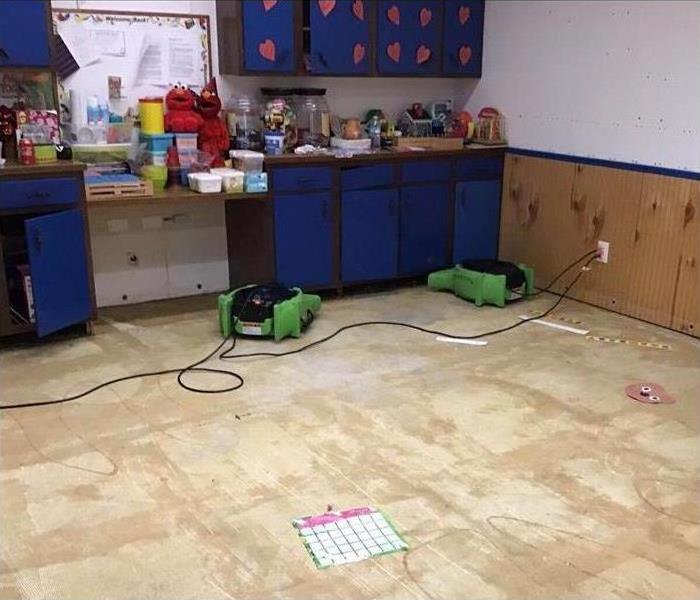 Cleaning up water damage should usually be left to a professional.
Cleaning up water damage should usually be left to a professional.
Fixing Broken Pipes
Bursting pipes can cause an incredible amount of damage in Bunker Hill Village, TX. Such damage can be extremely expensive, as you may need to completely rip out and restore large areas of your home. Even a single broken pipe can ruin nearly an entire room, and possible secondary damage can be even more devastating than obvious ruin from the water. When you need to fix a broken pipe and repair extensive damage, calling a qualified restoration company is usually the best idea.
Water Damage
Because most pipes are kept in hidden locations, you may not discover a broken pipe until extensive damage has already been done. Even small amounts of water left unattended can damage the following areas of your home:
- Sheetrock
- Baseboard
- Hardwood floors
- Carpet
- Rugs
- Insulation
Water damage may cause sheetrock to weaken and can even ruin insulation, resulting in expensive, time-consuming repairs. Expensive wood floors can be completely ruined when water soaks into the grain, causing floorboards to buckle and bow. The longer water stands unattended, the more damage it can do, so calling a restoration company immediately is usually the best way to minimize the problem.
Secondary Damage
While a lot of water damage is visible upon first inspection, you should investigate further to find any secondary damage that may have happened. Bursting pipes can cause many types of hidden damage, including:
Mold, mildew and bacteria grow best in warm, dark environments, so if a broken pipe is not detected quickly, the fungus could spread rapidly until it is out of control. Household cleaners may not be strong enough to get rid of existing mold and mildew, so it is a good idea to leave the treatment to a restoration company.
While many people may be able to fix a broken pipe, cleaning up water damage should usually be left to a professional. With the help of a restoration company, dealing with bursting pipes in Bunker Hill Village, TX can be a quick and manageable process.
Repairing Broken Pipes Quickly
1/30/2022 (Permalink)
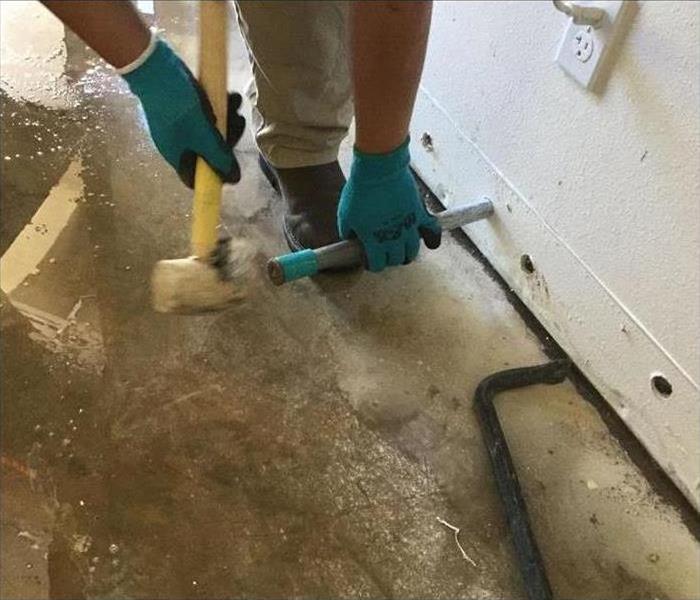 Water restoration after a pipe break.
Water restoration after a pipe break.
Prevent Water Damage
No matter how many precautions you take, sometimes it’s not possible to prevent bursting pipes. After prevention, the best thing you can do is react quickly to start repairs when it’s time to fix a broken pipe. The faster you act, the more you can prevent water damage in Houston, TX.
Limit the Mold, Limit the Damage
When a pipe bursts, the first thing you need to do after checking with the insurance company is fixing the broken pipe. Once the hole is plugged or the broken pipe replaced, you can begin cleaning up the water and repairing the damage with these steps:
- Call a professional to assess the damage
- Remove standing water and remove any items that are saturated
- Clean items that can be salvaged
- Throw away items that are dangerous to use or consume
The faster you remove the water and the wet items, the more water damage in Houston, TX you can prevent. This also limits the amount of mold growth you’ll experience, making your home safer and cleaner after the repair.
What To Keep, What To Throw Away
Unless you have black water flooding into your home, you should be able to clean most of your items and return them to use. Clothing or other cloth and canvas items need to be washed or dry cleaned. Floors should be sanitized and carpets cleaned. Any food or medical supplies should be thrown away and replaced. If you have black water in your home, you should throw away anything porous that was exposed, as those items can become breeding grounds for bacteria.
If you have water damage from a burst pipe in Houston, TX, the faster you move, the more damage you’ll be able to prevent. Getting your home and valuables cleaned, repaired or replaced as quickly as possible makes it easier to get back into all areas of your home quickly and safely.





 24/7 Emergency Service
24/7 Emergency Service










